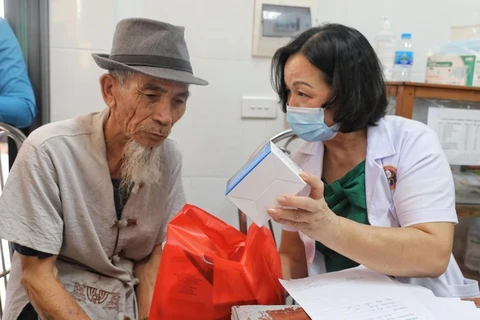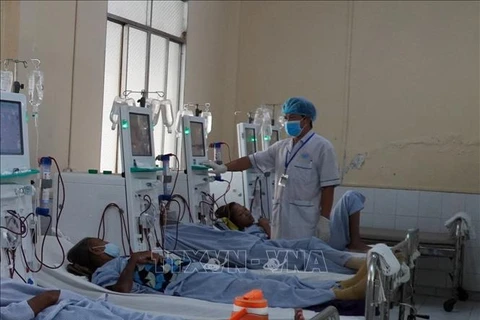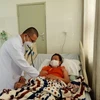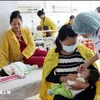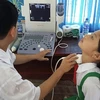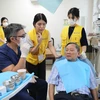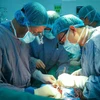 Hospitals develop professional and technical capacity for modern intensive care. (Photo: VietnamPlus)
Hospitals develop professional and technical capacity for modern intensive care. (Photo: VietnamPlus) Hanoi (VNA) - Deputy Prime Minister Tran Hong Ha has signed a decision approving the master planning scheme on the network of healthcare establishments for the 2021-2030 period, with a vision to 2050.
Associate Professor Phan Le Thu Hang, Deputy Director of the Department of Planning - Finance under the Ministry of Health who is also director of a project on investment and development of the grassroots healthcare system, speaks to VietnamPlus e-newspaper about orientations in developing the grassroots healthcare network in the coming time.
Reporter: Could you elaborate on the position of the master planning scheme on the grassroots healthcare network in the current general planning?
Associate Professor Phan Le Thu Hang: The current planning system has three main groups. They are national comprehensive planning schemes (national master planning scheme, national marine spatial planning scheme and national land use planning scheme), national sectoral planning schemes, and local planning schemes (regional planning schemes, provincial/city planning schemes).
The master planning scheme on the network of grassroots healthcare establishments is included in the national sectoral planning scheme. It will set forth planning for 2021-2030 period with a long-term vision (until 2050). The main content of the planning scheme is to define orientations for the development, distribution, and organisation of space and resources for regional, inter-provincial and interdisciplinary medical facilities.
Its objects are five regional-level, inter-provincial and interdisciplinary medical facilities in the fields of medical examination, treatment, and rehabilitation; forensic examination and forensic psychiatric examination; preventive medicine, public health; testing, inspection, and standardisation of drugs, cosmetics, food, vaccines and medical biological products, medical equipment, pharmaceutical production, vaccines, medical biological products and medical equipment; population and reproductive health.
 Phan Le Thu Hang, Deputy Director of the Department of Planning - Finance under the Ministry of Health (Photo: VietnamPlus)
Phan Le Thu Hang, Deputy Director of the Department of Planning - Finance under the Ministry of Health (Photo: VietnamPlus) The master planning scheme on the network of grassroots healthcare establishments does not include State management units in charge of the healthcare sector nor include local medical facilities which belong to the provincial planning scheme. It provides orientations to guide localities to incorporate the network of local healthcare establishments into the provincial master planning schemes.
Reporter: What basic concepts the master planning on the network of medical establishments is built on?
Associate Professor Phan Le Thu Hang: The master planning on the network of healthcare establishments is devised on the basis of six basic development perspectives.
It is consistent with major national orientations, including national development orientations and visions; socio-economic development strategies; national master planning scheme and other relevant national planning schemes.
It ensures comprehensive, integrated, and continuous service provision with convenient access and financial protection. It also ensures health security, responds to climate change and emergency situations.
Particularly, developing the network of grassroots healthcare establishments is associated with innovation of the organisational structure and management methods with a view to improving quality and operational efficiency. Developing the network of medical facilities aims to ensure balance, synchronisation, and effective connection between the network of medical facilities at the national level and local ones.
The network of medical facilities will be developed towards the direction of harmonious combination of grassroots and specialised healthcare; between traditional medicine and modern medicine; between medical facilities of the armed forces and civil establishments associated with building national defence and security medical potential.
Investment resources will be maximised to develop the network of medical facilities in line with the planning, coupled with effective use of investment resources.
It ensures fairness and gradually narrows the development gap between regions towards universal access to quality healthcare services.
Reporter: What is noteworthy about the development goals defined in the master plan?
Associate Professor Phan Le Thu Hang: The master planning scheme has been consistent with the goals of equity, quality, efficiency and international integration, enhancing people's access to medical services and having enough capacity to meet the needs of protecting, caring for and improving public health in each period as well as gradually approaching the health systems of advanced countries in the region and the world.
The master planning scheme has set the target that by 2050, Vietnam’s indicators relating to hospital bed and key healthcare workers will reach the average level of the countries belonged to the Organisation for Economic Co-operation and Development (OECD).
Reporter: Could you share new orientations in developing the network of medical facilities in the future?
Associate Professor Phan Le Thu Hang: Regarding medical examination and treatment, the grassroots healthcare network will be developed towards fairness, efficiency, development and international integration through the development of professional and technical capacity intensive care, increase the supply of tertiary care services; enhance the geographic distribution of hospitals providing tertiary care to improve geographic access and ensure the role of regional response when epidemics and disasters occur.
 President Vo Van Thuong (third from the right) visits a health station of Thanh Phong commune in Thanh Liem district, Ha Nam province. (Photo: VNA)
President Vo Van Thuong (third from the right) visits a health station of Thanh Phong commune in Thanh Liem district, Ha Nam province. (Photo: VNA) As for preventive medicine and public health, the master planning scheme will look to set up the Central Disease Control Agency with a level-4 biosafety laboratory system and three regional centres for disease control with level-3 biosafety laboratory systems, along with institutes of hygiene and epidemiology to take over the role of connecting and supporting provincial centres for disease control.
Regarding testing, inspection, and calibration, technical and professional capacity at both national and regional levels will be improved through enhancing the capacity of national specialised institutes and developing six regional testing centres in six socio-economic regions, upgrading quality control centres for medical laboratory to undertake regional functions.
As for forensic examination and forensic psychiatric examination, the plan will improve capacity and facilities of units engaged in forensic examination and forensic psychiatric examination. It will look to build a regional forensic facility in Ho Chi Minh City and two regional forensic psychiatric examination facilities in Nghe An province and HCM City.
Regarding population and reproductive health, six regional prenatal and newborn screening and diagnosis facilities in the Red River Delta, North Central, Central Coast, Southeast regions and Mekong Delta will be expanded along with the establishment of two regional prenatal and newborn screening and diagnosis facilities in the northern midlands and mountainous regions and the Central Highlands. Specialised technical services for elderly health care will be developed in association with geriatric hospitals or hospitals with geriatric units. A geriatric hospital in the Mekong Delta will also be built.
The proportion of private hospital beds is set to account for 15% by 2030 and 25% by 2050.
Reporter: For the long-term vision, the master planning scheme looks to build two in-depth healthcare complexes when there are enough conditions in the northern and southern regions. Could you tell us more about this orientation?
Associate Professor Phan Le Thu Hang: The medical complex is considered a model to create a boost for innovation and high-tech development of the entire healthcare sector, align with the goal of forming a modern healthcare system as well as the mindset that healthcare is a service industry which is capable of directly contributing to the country’s economic growth.
 A doctor uses ultrasound imaging to diagnose the condition of a patient at Dinh Hoa General Hospital (Photo: VNA)
A doctor uses ultrasound imaging to diagnose the condition of a patient at Dinh Hoa General Hospital (Photo: VNA) The medical complex is considered the most suitable for medical facilities with large and complex laboratory system; high-tech biomedical research and development centres; large medical human resources training facilities; high-tech medical examination and treatment facilities; research and production facilities for pharmaceuticals, biological products and high-tech medical equipment.
The model will create space for sharing medical technical infrastructure between medical facilities, especially between laboratory systems as well as for connection between research, development, human resource training and design of high-tech medical and pharmaceutical products.
Reporter: Thank you very much!

